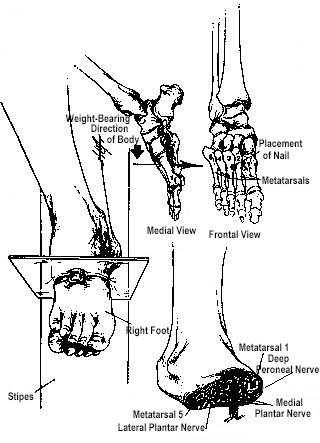
Nailing of feet. Left, Position of feet atop one another and against stipes. Upper right, Location of nail in second intermetatarsal space. Lower right, Cross section of foot, at plane indicated at left, showing path of nail. |
Not uncommonly, insects would light upon or
burrow into the open wounds or the eyes, ears,
and nose of the dying and helpless victim, and
birds of prey would tear at these sites. (16)
Moreover, it was customary to leave the corpse on
the cross to be devoured by predatory animals.
(3,11,12,28) |
|
However, by Roman law, the family of
the condemned could take the body for burial,
after obtaining permission from the Roman judge.
(11) Since no one was intended to survive crucifixion, the body was not released to the family until the soldiers were sure that the victim was dead. By custom, one of the Roman guards would pierce the body with a sword or lance. (3,11) Traditionally, this had been considered a spear wound to the heart through the right side of the chest -- a fatal wound probably taught to most Roman soldiers. (11) The Shroud of Turin documents this form of injury. (5,11,22) Moreover, the standard infantry spear, which was 5 to 6 ft (1.5 to 1.8 m) long (30) could easily have reached the chest of a man crucified on the customary low cross. (11) Medical Aspects of Crucifixion With a knowledge of both anatomy and ancient crucifixion practices, one may reconstruct the probably medical aspects of this form of slow execution. Each wound apparently was intended to produce intense agony, and the contributing causes of death were numerous. The scourging prior to crucifixion served to weaken the condemned man and, if blood loss was considerable, to produce orthostatic hypotension and even hypovolemic shock. (8, 12) When the victim was thrown to the ground on his back, in preparation for transfixion of his hands, his scourging wounds most likely would become torn open again and contaminated with dirt. (2,14) Furthermore, with each respiration, the painful scourging wounds would be scraped against the rough wood of the stipes. (7) As a result, blood loss from the back probably would continue throughout the crucifixion ordeal. With arms outstretched but not taut, the wrists were nailed to the patibulum. (7,11) It has been shown that the ligaments and bones of the wrist can support the weight of a body hanging from them , but the palms cannot. (11) Accordingly, the iron spikes probably were driven between the radius and the carpals or between the two rows of carpal bones, (2,10,11,30) either proximal to or through the strong bandlike flexor retinaculum and the various intercarpal ligaments. Although a nail in either location in the wrist might pass between the bony elements and thereby produce no fractures, the likelihood of painful periosteal injury would seem great. Furthermore, the driven nail would crush or sever the rather large sensorimotor median nerve. (2,7,11) The stimulated nerve would produce excruciating bolts of fiery pain in both arms. (7,9) Although the severed median nerve would result in paralysis of a portion of the hand, ischemic contractures and impalement of various ligaments by the iron spike might produce a clawlike grasp. | |
| Back | Next |